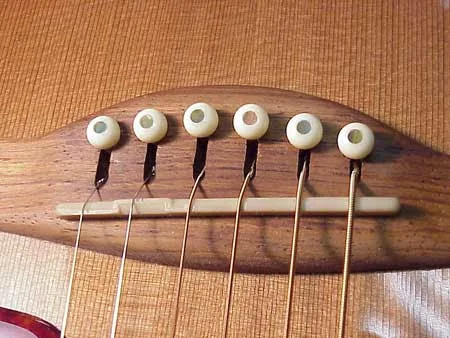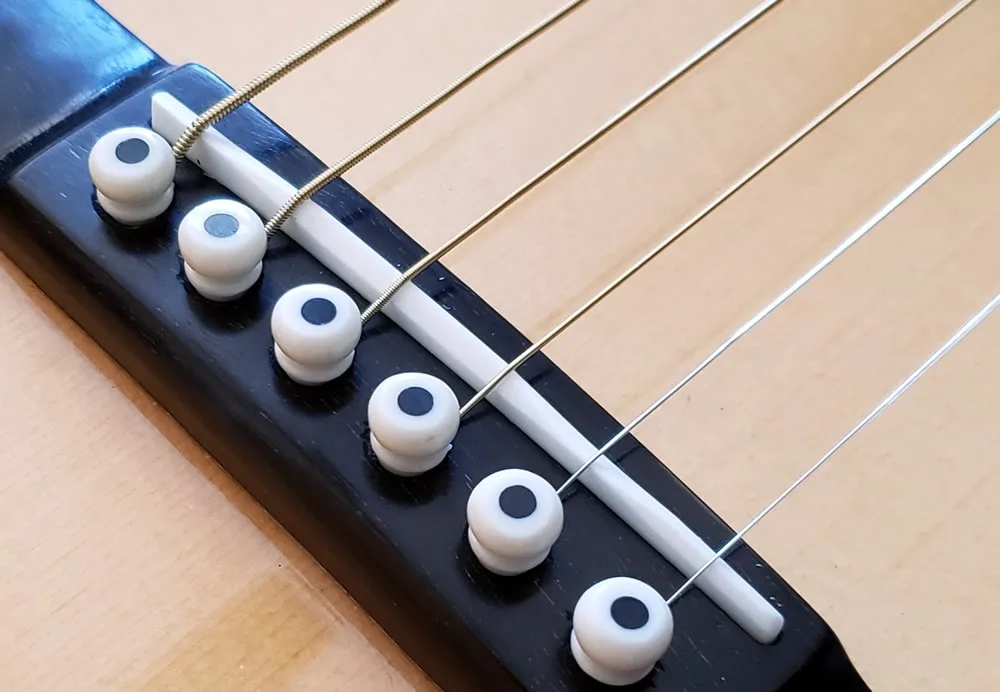What is a guitar saddle and why is it important? If you’re new to playing the guitar, you may have heard this term before but aren’t quite sure what it means. Don’t worry, you’re not alone! As someone who has been playing the guitar for years, I remember being confused about this myself when I first started learning.
In this article, we’ll explore everything you need to know about guitar saddles- from its purpose to different types and how it affects your overall playing experience. Whether you’re an absolute beginner or just looking to expand your knowledge on guitars, understanding the importance of a saddle is crucial in achieving optimal sound quality and playability. So let’s dive into this guide and learn all about guitar saddles together!
So, what is a guitar saddle?
A guitar saddle is a small piece of material, often made of plastic or bone, that sits on the bridge of a guitar and supports the strings. It may seem like a small and insignificant component, but it plays a crucial role in the overall sound and playability of the instrument.
The main function of a guitar saddle is to transfer vibrations from the strings to the body of the guitar. This helps produce clear and resonant notes when playing. The height and angle of the saddle also affect string action, which refers to how high or low the strings sit above the fretboard.
Having proper string action is essential for comfortable playing as well as maintaining intonation (the accuracy of each note). If your saddle is too high or too low, it can cause buzzing or make it difficult to play certain chords correctly.
Additionally, different materials used for saddles can impact tone quality. For example, bone saddles are known for producing brighter tones while plastic saddles tend to have warmer tones.
Overall, understanding what a guitar saddle does and its importance in creating good sound quality can help beginner guitarists choose an appropriate one for their instrument and maintain its optimal performance.
Understanding the Function of a Guitar Saddle
The guitar saddle, often made from materials like plastic, bone, or wood, plays a crucial role in the overall sound and playability of the instrument. Sitting atop the bridge of an acoustic or electric guitar, it was designed to hold the strings at a specific height above the fretboard. This arrangement ensures that each note played is clear and resonant. If you look closely at your guitar’s saddle, you’ll notice that its shape can influence intonation—the accuracy of pitch as you move along the neck. A well-shaped saddle allows for optimal string vibration transmission into the body of the guitar.
Furthermore, saddles contribute significantly to action height and tuning stability. When properly adjusted, they help maintain a comfortable distance between strings and frets—an important factor for easy playing without buzzing sounds. In many cases, players may customize their saddles by adjusting their height or even replacing them with different materials to achieve distinct tonal qualities or enhanced sustain. Ultimately, understanding this small but mighty component can enhance your experience as both a guitarist and an auditory explorer in this melodic journey!
Read also: 3 string cigar box guitar strings
Exploring Different Types of Guitar Saddles
When you look closely at a guitar, the saddle might not be the first thing that catches your eye. However, this small piece plays a crucial role in shaping the instrument’s sound and playability. There are different types of guitar saddles, each made from various materials like plastic, bone, or metal. For instance, plastic saddles are common on budget guitars; they’re lightweight and inexpensive but may not enhance tone as well as others. On the other hand, bone saddles offer a richer sound due to their density and natural resonant qualities. Players often favor bone for its ability to bring out warmth in acoustic tones.
Another intriguing option is the compensated saddle, designed with slight adjustments to string length at each position. This ensures better intonation across frets, allowing musicians to hit notes accurately no matter where they play on the neck. If you’re into electric guitars, you might encounter metallic saddles that improve sustain while offering durability against wear and tear from strings. Whether you’re strumming chords or playing intricate solos, understanding these different types can help you choose what suits your style best! So next time you pick up a guitar, consider how that little saddle contributes to your musical journey!

How to Adjust and Care for Your Guitar Saddle
Taking care of your guitar saddle is essential for achieving the best sound from your instrument. The saddle, usually made of materials like bone or plastic, plays a vital role in transferring vibrations from the strings to the body of the guitar. If you notice that your strings are buzzing or if you’re having trouble tuning, it might be time to check and adjust this little component. To begin with, ensure that the height of the saddle aligns with your playing style; this can mean making subtle adjustments by sanding it down to lower action or shimming it up for higher playability.
Regular maintenance is equally important; keeping an eye on wear and tear will help you catch issues early. A simple way to care for your saddle involves cleaning it gently using a soft cloth after each session, removing any dust buildup that could dampen its performance. Additionally, consider checking how well it’s seated in its slot; if it’s loose or wobbly, use glue specifically designed for musical instruments to secure it back in place properly. Taking these steps ensures not just longevity but also enhances your overall playing experience! Remember: a well-cared-for saddle means richer tones and happier strumming!
The Impact of a Guitar Saddle on Sound Quality and Playability
The guitar saddle, a small but vital component of stringed instruments, plays a crucial role in shaping the sound and feel of the music produced. Positioned on top of the bridge, it acts as a pivotal point where vibrations from the strings are transferred to the body of the guitar. Different materials used for saddles—such as plastic, bone, or brass—can significantly influence tonal quality. For instance, bone tends to enhance projection and warmth in sound, while synthetic options might offer durability at lower costs. Furthermore, slight adjustments to saddle height can transform playability; raising it may make fretting more challenging but can improve sustain and volume.
Beyond just materials and height adjustments, the saddle’s design also matters immensely. A well-crafted saddle allows for proper intonation; this means that notes played along different frets stay true to their pitch without becoming flat or sharp. Additionally, if players have preferences about string spacing or action height (the distance between strings and fretboard), customized saddles can cater specifically to those needs. Ultimately, understanding how these elements intertwine empowers musicians to fine-tune not only their instrument’s tone but also their playing experience itself.
When investing time in guitar setup or modification, paying attention to this little piece often leads to profound effects on overall performance.
You may also like: what guitar does dave grohl play
Conclusion: Why the Guitar Saddle is Critical for Beginners
When starting out on the guitar, one often overlooks the importance of the saddle. This small yet mighty component sits on top of the bridge and plays a vital role in shaping sound. The saddle helps to transfer vibrations from the strings to the body of the guitar, affecting tone and volume significantly. If it’s not set correctly, even a beginner can feel frustrated by their instrument’s performance. A well-adjusted saddle ensures proper string height, making it easier for new players to press down on chords without excessive effort.
Moreover, beginners should recognize that a poorly aligned saddle can lead to intonation issues. Intonation refers to how in-tune your guitar is across different frets; if this isn’t right, notes may sound sour as you play up and down the neck. With an accurate setup from day one, aspiring musicians can build confidence in their skills and enjoy their learning experience more fully. In essence:
- A properly fitted saddle enhances playability.
- It impacts overall tone.
- Correct intonation allows for smoother playing.
Taking care of these details fosters passion for music right from those first strums!

